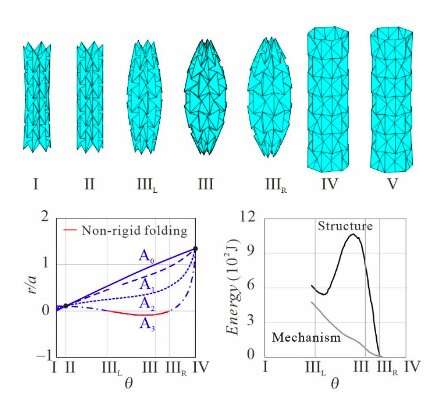May 8, 2020 feature
A model for the origami-inspired folding of a tubular waterbomb

In recent years, research teams worldwide have been trying to apply origami-folding strategies to mechanical structures, as this could allow them to change their shape both rapidly and efficiently. A key advantage of origami, the Japanese art that entails folding pieces of paper to form structures, is that its strategies tend to work regardless of the size and composition of the material that is being folded.
Researchers at Tianjin University in China have recently investigated the use of origami-folding strategies to create a structure known as a tubular waterbomb. The strategies they employed, involving both rigid (i.e., with the rotation of crease lines) and nonrigid (i.e., with the rotation of crease lines and the distortion of facets) origami techniques, are outlined in a paper published in the SPJ Research journal.
Via email, Yan Chen, Zhong You and Jiayao Ma, the researchers who carried out the study, told TechXplore, "We have worked on waterbomb tubes since the beginning of the 21st century, when we came up with the idea of designing an origami stent graft. The project turned out to be a success, but we did not know exactly what really happened during the folding of the origami stent. Recently, enthusiasm on the waterbomb tube was reignited as we started studying waterbomb-based mechanical metamaterials."
The mechanical properties of metamaterials used for origami typically depend on the folding behaviors that one is trying to reproduce. To program and fine-tune the properties of a material so that it matches a particular origami-folding strategy, one should first devise a theoretical model that characterizes the material's unique folding mechanics.
Initially, Chen, You, Ma and their colleagues started developing a model that could characterize the folding mechanics of a waterbomb tube. This ultimately allowed them to figure out the real folding behavior of the tubular structure they examined when origami strategies were applied to it.
"We adopted a combined kinematic and structural analysis approach," Chen, You and Ma explained. "We first built a kinematic model to analyze whether a tubular waterbomb is capable of rigid origami folding, where the deformation comes only from rotation of creases."
In cases where the waterbomb could be folded using rigid origami strategies, the researchers calculated the range of geometric parameters necessary for it to fold, as well as the exact configuration of the waterbomb tube at different stages of the folding process. When the structure could not be folded using rigid origami strategies, as both creases and facets had to be deformed for it to change shape, they used a method known as structural analysis. This method allowed them to determine how the tubular waterbomb had to be distorted during folding and the mechanical properties associated with these distortions.
"Using this approach, we unveiled for the first time the mechanism-structure-mechanism transition during the folding of a tubular waterbomb and explained the dramatic change in its structural stiffness during transitions," the researchers explained. "More importantly, the theoretical model we devised allowed us to program the folding behavior of the waterbomb, dictating whether a transition happens, and if so, exactly where it happens."
The study has a number of important implications. In addition to successfully applying origami-inspired strategies to a complex tubular structure, it introduces a rigorous theoretical model that shows exactly what happens during the radial folding of the structure.
The model devised by Chen, You, Ma and their colleagues makes controlling and fine-tuning the behavior of a tubular waterbomb possible, thus opening up interesting possibilities for a variety of engineering applications. For instance, the model could be used to build an origami-based wheel, allowing researchers to predict the exact configurations it can attain and how much deformation it will be subjected to during the folding process; thereby achieving a high motion accuracy.
"The analysis framework developed here would greatly boost our long-tern endeavor to developing and characterizing origami-inspired metamaterials with programmable and tunable mechanical properties, especially those with non-rigid-foldable origami patterns," the researchers said, "In the future, we aim to explore waterbomb patterns with more generalized geometric parameters with the aim of uncovering more fascinating features intrinsic to this historic pattern."
More information: Jiayao Ma et al. Folding of Tubular Waterbomb, Research (2020). DOI: 10.34133/2020/1735081
© 2020 Science X Network

















